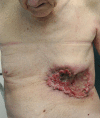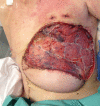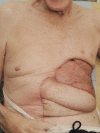Giant anterior chest wall basal cell carcinoma: a reconstructive challenge and review of the literature
- PMID: 23598936
- PMCID: PMC3645802
- DOI: 10.1136/bcr-2013-008871
Giant anterior chest wall basal cell carcinoma: a reconstructive challenge and review of the literature
Abstract
Giant basal cell carcinomas (GBCC) are rare, accounting for <1% of BCCs. Those occurring on the anterior chest wall are a very rare subset that brings particular reconstructive challenges. We describe a 75-year-old man whose 13.5 cm diameter ulcerating GBCC on his left anterior chest came to medical attention following a fall. The lesion was resected en-bloc with adjacent ribs, and reconstructed with an omental flap, superiorly pedicled vertical rectus abdominus myocutaneous (VRAM) flap and split skin grafting. While the myriad reasons for delayed presentation of giant cutaneous malignancies are well documented, the complex nature of reconstruction and requirement for an integrated multidisciplinary approach are less so. It is of importance to note that the cicatricial nature of these lesions may result in a much larger defect requiring reconstruction than appreciated prior to resection. Documented cases of anterior chest wall GBCC and the treatment strategies employed are reviewed.
Figures




Similar articles
-
Delayed vertical rectus abdominis myocutaneous flap for anterior chest wall reconstruction.Aesthetic Plast Surg. 2006 Jan-Feb;30(1):120-4. doi: 10.1007/s00266-005-0145-6. Aesthetic Plast Surg. 2006. PMID: 16402161
-
Giant anterior chest-wall basal-cell carcinoma.Eur J Cardiothorac Surg. 2011 May;39(5):793. doi: 10.1016/j.ejcts.2010.08.044. Epub 2010 Oct 6. Eur J Cardiothorac Surg. 2011. PMID: 20932771 No abstract available.
-
Giant basal cell carcinoma of the anterior chest wall with bone invasion.Eur J Cardiothorac Surg. 2014 May;45(5):945-6. doi: 10.1093/ejcts/ezt416. Epub 2013 Sep 11. Eur J Cardiothorac Surg. 2014. PMID: 24026857
-
Reconstruction of the chestwall and thorax.J Surg Oncol. 2006 Nov 1;94(6):455-65. doi: 10.1002/jso.20482. J Surg Oncol. 2006. PMID: 17061266 Review.
-
Flow-through omental flap to free anterolateral thigh flap for complex chest wall reconstruction: Case report and review of the literature.Microsurgery. 2016 Jan;36(1):70-6. doi: 10.1002/micr.22444. Epub 2015 Jul 3. Microsurgery. 2016. PMID: 26140609 Review.
Cited by
-
Giant basal cell carcinoma of the back in an elderly lady-excision and OZ plasty.J Surg Case Rep. 2025 Aug 20;2025(8):rjaf589. doi: 10.1093/jscr/rjaf589. eCollection 2025 Aug. J Surg Case Rep. 2025. PMID: 40842486 Free PMC article.
-
Case report: Sequential treatment strategy for advanced basal cell carcinoma in Gorlin-Goltz syndrome: integration of vismodegib, radiotherapy, surgery, and high-intensity focused ultrasound.Front Oncol. 2024 Jul 18;14:1428702. doi: 10.3389/fonc.2024.1428702. eCollection 2024. Front Oncol. 2024. PMID: 39091908 Free PMC article.
-
Giant Anterior Chest Wall Basal Cell Carcinoma: An Approach to Palliative Reconstruction.Case Rep Oncol Med. 2016;2016:5067817. doi: 10.1155/2016/5067817. Epub 2016 Dec 19. Case Rep Oncol Med. 2016. PMID: 28083152 Free PMC article.
-
Versatility of the O-Z flap for back reconstruction after giant basal cell carcinoma resection: A case report and review of the literature.Int J Surg Case Rep. 2019;63:23-26. doi: 10.1016/j.ijscr.2019.08.034. Epub 2019 Sep 11. Int J Surg Case Rep. 2019. PMID: 31557720 Free PMC article.
-
Complex anterior chest wall reconstruction after extensive oncologic resections: a narrative review.Shanghai Chest. 2021 Oct;5:41. doi: 10.21037/shc-21-8. Epub 2021 Oct 30. Shanghai Chest. 2021. PMID: 35495182 Free PMC article.
References
-
- Randle HW, Roenigk RK, Brodland DG. Giant basal cell carcinoma (T3): who is at risk? Cancer 1993;2013:1624–30 - PubMed
-
- Archontaki M, Stavrianos SP, Korkolis DP, et al. Giant basal cell carcinoma: clinicopathological analysis of 51 cases and review of the literature. Anticancer Res 2009;2013:2655–64 - PubMed
-
- Horlock N, Wilson GD, Daley FM, et al. Cellular proliferation characteristics do not account for the behaviour of horrifying basal cell carcinoma. A comparison of the growth fraction of horrifying and non-horrifying tumours. Br J Plast Surg 1998;2013:59–66 - PubMed
-
- Snow SN, Sahl W, Lo JS, et al. Metastatic basal cell carcinoma. Cancer 1994;2013:328–35 - PubMed
Publication types
MeSH terms
LinkOut - more resources
Full Text Sources
Other Literature Sources
Medical
Research Materials
